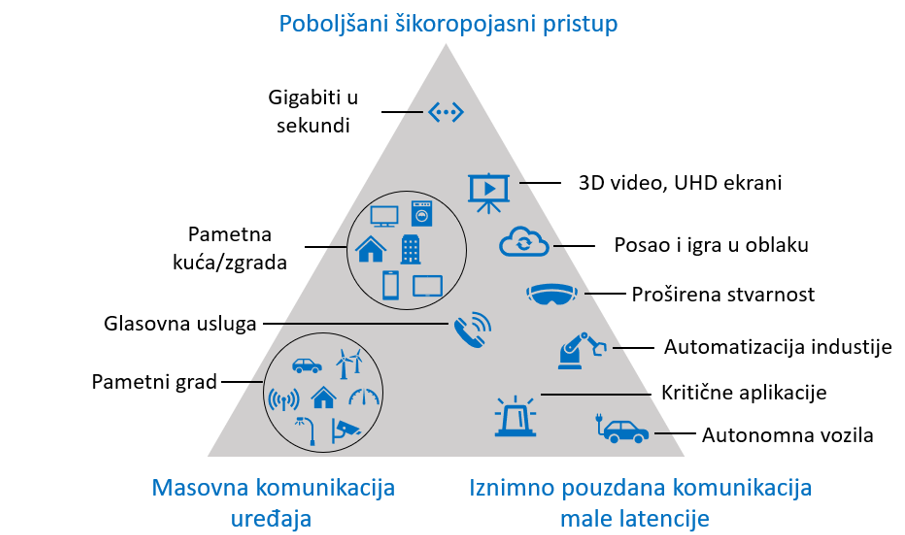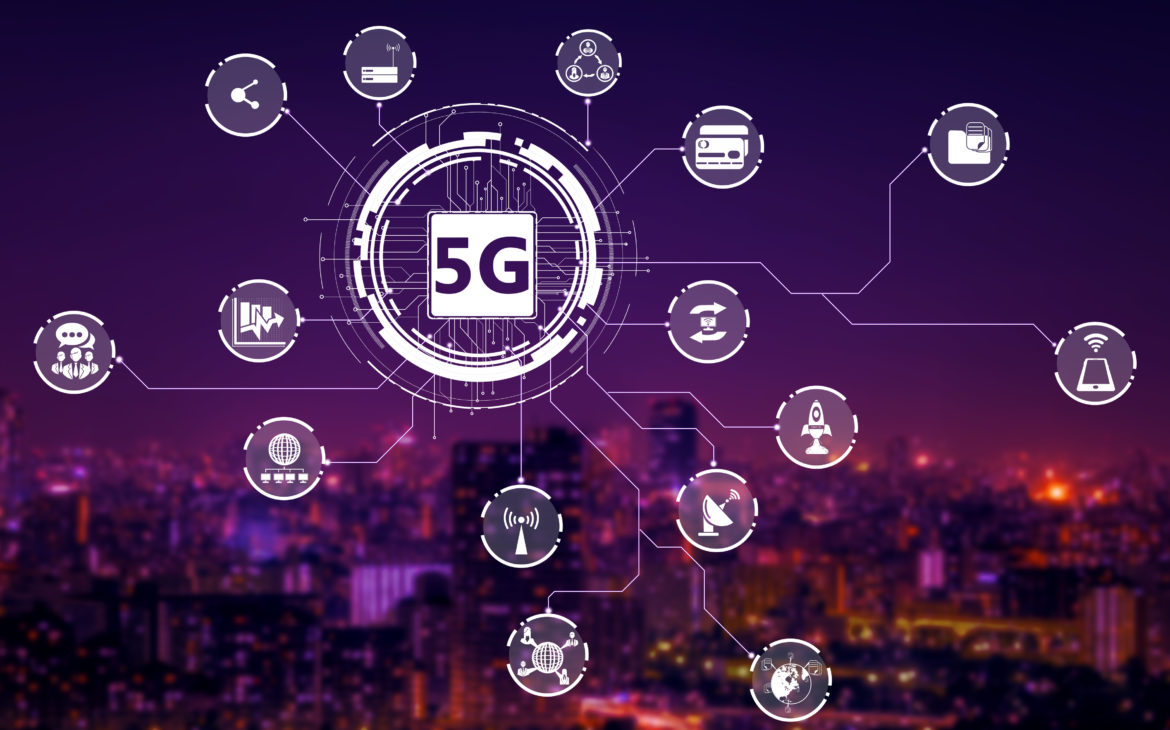In the previous feature on the motivation behind introducing a fifth-generation mobile network, one of the mentioned drivers of development was the emergence of new use cases, i.e. scenarios of network use that have not been considered so far when developing previous generations of mobile networks.
This article provides an overview of the use cases considered in the proposals for 5G network development and proceeds to describe the types of service whose provision will produce a satisfactory quality of service for the related use cases.
Use cases of the 5G network
5G use cases represent the scenarios in which this network can be used that were impossible thus far or have failed to achieve satisfactory quality of service (QoS). One group of such scenarios is broadband access in areas with high density of people, such as: large gatherings (concerts, sporting events…), city centers, and residential or commercial buildings. In such places occurs the problem of network congestion, as a large number of people in a small geographical area wants to access the network at the same time. The other extreme are uninhabited or sparsely populated areas that have poor coverage due to the small number of regular users. The goal of the 5G network is to provide equal quality of experience (QoE) to all users regardless of their location of access to the service. In today’s context of broadband service, this includes transmission speeds of at least 50 Mbit/s. Furthermore, advanced scenarios of user mobility are considered, i.e. the use of mobile services in high-speed means of transport (e.g. complex mobile services while during car or train rides). This poses a challenge in itself because the quality of service decreases as user speed increases. It is also necessary to provide public safety officers with unhindered and secure communication in the event of natural disasters or other emergencies. This communication has so far been taking place over private networks, which require high costs of infrastructure investment. In this respect, the 5G network enables priority and robust communication tailored to the needs of the situation (e.g. simple services, locating options, low power consumption).
In addition to person-centric services, there are various types of device-centric services – currently the most popular being massive Internet of Things (mIoT). This concept implies the connection and independent communication of vast numbers of different devices that consume small amounts of data (from sensors and smart wearable devices to smart city technology and drones). Of course, such devices do not require the same type of service as humans, and the network traffic they generate also differs. Therefore, the network behavior should adapt to this form of communication. A step further in the complexity of realization is extreme real-time communication. This use case is a form of communication intended for wireless internet-based of real or virtual objects (so-called tactile internet). The latency expected when providing this service can be less than a millisecond. Besides latency, there are many scenarios that require exceptional communication reliability. Reliability is especially important for autonomous driving, robot and drone control, remote treatment and surgery.
Types of 5G services
Types of services are one of the biggest differences between the 5G network and previous generations of mobile networks, and the basis for directing the development of new network architecture. They enable more precise management of services so that each individual service can meet its QoS requirements. To successfully manage service types, the 5G network architecture is based on innovative concepts such as network slicing, virtualization, and control user plane separation.
The 5G mobile network defines three types of services that successfully cover all considered use cases:
- enhanced Mobile Broadband (eMBB)
- Ultra-Reliable Low Latency Communication (URLLC)
- massive Machine-Type Communication (mMTC).
Their characteristics are described in more detail below.
Enhanced Mobile Broadband is the expected upgrade to the service we currently use in 4G broadband. This type of broadband service is intended for human communication, i.e. to access multimedia content, services and data. Enhanced Mobile Broadband services include, for example, ultra-high definition (UHD) streaming and virtual reality (VR). On the user side, the new services will require higher transfer speeds and cloud computing resources to perform complex data processing. In terms of network performance, emphasis is placed on increasing network capacity, coverage, bandwidth, and mobility, depending on the specific situation of service usage. The global goal is to provide satisfactory quality of service anytime, anywhere. Achieving particular network performance is always a compromise because increasing one feature most often causes decreasing another. For instance, expanding network coverage area causes lower transmission speeds. Therefore, mobile network planning seeks to select the architecture and technology that best suits the expected performance in real situations. 5G broadband service can be improved in two ways:
- by using new frequency bands
- through advanced multi-antenna systems that enable massive MIMO and beamforming.
New (additional) frequency bands expand the resources used for mobile communication, which in turn means better performance. Particularly interesting is the frequency spectrum of millimeter waves, where it is possible to achieve extremely high transmission speeds. The drawback of communication in the millimeter-wave band is low range and sensitivity to weather conditions, which is resolved by beamforming. Advanced multi-antenna systems achieve better utilization of communication resources, and thus better performance and consequent QoS improvement.
Ultra-reliable low latency communication is another type of service that involves new use cases with strict latency and reliability requirements. So, the required performance goes up to a latency of 1 ms and a reliability of 99.999%. For comparison, in 4G networks the achievable latency is 10 ms, with around 99% reliability. Achieving better performance in terms of latency and reliability has not been necessary so far, as most mobile service users were people accessing the network via smartphones. The emergence of new services with stringent latency and reliability requirements entails changes to the network architecture that include 5G New Radio (5G NR), edge computing, and redundant communication paths like dual connectivity. This type of service is primarily related to services aimed at people in the field of security and health, although multiple applications of this type of service are focused on device communication. This includes services or devices that expect precise real-time communication; therefore, autonomous vehicles (driverless), real-time traffic management, advanced power grid, smart devices used to communicate accidents or emergencies, and industrial communication (e.g. wireless control of manufacturing equipment).
Massive machine-type communication is a type of service characterized by the connection of extremely large numbers of devices that intermittently transmit small amounts of traffic with mild QoS requirements. Mild quality of service requirements in this context mean that low transmission speeds are enough to achieve this type of service, which allows higher delays, as these are not devices whose functionality depends on real-time messaging. It is important that the devices themselves are affordable and have long battery life, since they are designed to function independently without human intervention for a longer period of time. The best practical example of this type of service are smart cities – which may include, for instance, parking sensor technology, smart lighting or surveillance systems. For this type of service, the network must achieve wide coverage and connectivity of multitudes of devices without congestion. Therefore, the development of the mobile network is directed towards techniques for more effective management of large numbers of users on the frequency spectrum (e.g. multiple access).

The diagram (Figure 1) shows the relationship of each use case with the defined types of services, where the corners represent the use cases fully characterized by a particular type of service, while those within the triangle share the characteristics of each type. In terms of QoS requirements, eMBB corresponds to high transmission speeds, mMTC corresponds to high connectivity, while URLLC corresponds to low latency and high reliability.
